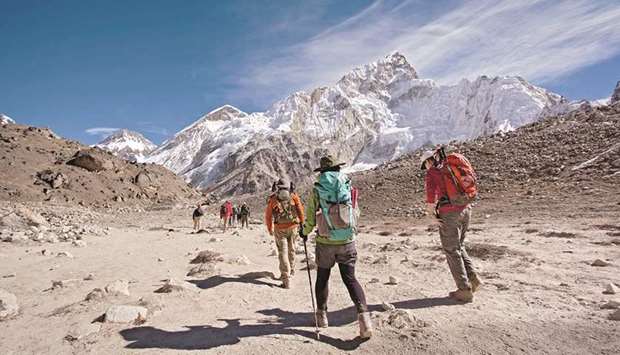Wedged between colossal China and India, Nepal is the rock stage for tourism. Nepalis generally make two points to introduce their country, first Mount Everest, the highest snow peak and, second, the birthplace of Lord Buddha. Tourists generally look at the medieval architectures in three of the Durbar Squares in the Kathmandu Valley, the country’s capital, before rushing into mountains, what the country is famous for. Amidst several mountainous route options available, tourists frequently opt for Everest Base Camp Trek or Annapurna Treks.
The first of the two Annapurna Treks, or Circuit Trek, known as one of the best trek routes in the world, starts from Besi Bazaar and ends on Jomsom. It takes more than 2 weeks to complete the trek as it elevates parallel to the Marshyangdi River into 5416m and falls back onto Kali Gandaki Valley. Tourists generally fly to Pokhara, a city west of Kathmandu, and from there they take bus or jeep to Besi Bazaar. From Besi Bazaar, one can go to Bhulbhule by jeep or hike.
Bhulbhule offers some picturesque views of elegant Himalchuli and Mansalu II mountains. Passing Bhulbhule, the trek moves from Ngadi to Ghermu through Bahundanda, Lili Bhir and Kanigaon. The high waterfall at Bahundanda is a hotspot for tourists to relax before getting back on feet and taking the trek. The trail from Ghermu, once a salt trade point, meets Chame and further goes to Tal. On the way from Tal to Chame, the majestic Annapurna II is pretty visible with stunning views of nature and snowcapped mountains. If you’re on the way from Chame to Pisang, do not forget to have a look at the rare relic of glacier erosion. The trail from Pisang thereafter moves to Manang. Tourists have to acclimatise, adjust to high altitude climate in Manang before gasping up further 2000m to Thorung La at 5416m. After leaving Marshyangdi River, the trail comes to Yak Kharka through where one comes to Thorung Phedi. From Thorung Phedi, it takes a day to reach Muktinath, a famous Hindu temple.
One can see Buddhist monks and Hindu devotees wearing saffron coming from as far as South India to worship at Muktinath. From Muktinath, trail comes to an end at Jomsom with Kagbeni in the middle. Kagbeni is beautiful trans-Himalayan barren alike Tibet. From high altitude city of Jomsom, you can get back to Pokhara through Naya Pul.
The alternative to Annapurna Trek, or Sanctuary Trek, starts from warmer paddy meadows and penetrates deep onto snowy Machhapuchhare Base Camp (3700m) and Annapurna Base Camp (4130m).
The spectacular journey of Annapurna Trek is widely recommended by travel magazines and blogs. The trek blends hill and mountain cultures with the spectacular beauty of the landscape. One comes across three specific people and their cultures, Gurungs, Manangis and Thakalis.
There is vast climatic diversity within Nepal, from Gangetic plains on south to the arresting mountains on the north. The north of Nepal is the final destination for the mountain lovers from all over the world. On north, tourists love the rush of adrenaline in their veins enjoying paragliding, climbing, mountain biking, bungee jumping and rafting. On deep north, it is about walking and climbing.
Opened in 1977, Annapurna trek can be gently stated as an epitome of Nepal’s rugged terrains, lush green meadows and snowcapped mountains extending all the way to Tibet. The best season to walk around Annapurna is from October to November.

EXTENSIVE: It takes more than 2 weeks to complete the Annapurna Trek as it elevates parallel to the Marshyangdi River into 5416m and falls back onto Kali Gandaki Valley.


